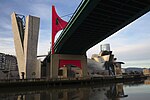Deportivo fronton
1931 establishments in Spain2011 disestablishments in SpainBasque pelotaFronton (court)Sport in Bilbao ... and 2 more
Sports venues completed in 1931Sports venues in the Basque Country (autonomous community)
The Deportivo fronton is a Basque pelota fronton, used mainly in the modalities of hand-pelota, short bat, long bat, pala and paleta. It is located in Bilbao and owned by the local municipality. The 52-meter-long facility closed to the public in 2011 (it is still used by the sports club based there, with reduced playing dimensions), with events in the city moving to the Bizkaia fronton in the Miribilla district.The fronton was home to the 1944 and 1957 1st Hand-Pelota singles championship, and the 1958, 1959, 1960 and 1994 2nd Hand-Pelota singles championship.
Excerpt from the Wikipedia article Deportivo fronton (License: CC BY-SA 3.0, Authors).Deportivo fronton
Alameda Recalde / Recalde zumarkalea, Bilbao Abando
Geographical coordinates (GPS) Address Nearby Places Show on map
Geographical coordinates (GPS)
| Latitude | Longitude |
|---|---|
| N 43.264816 ° | E -2.934827 ° |
Address
Salottihome
Alameda Recalde / Recalde zumarkalea
48009 Bilbao, Abando
Autonomous Community of the Basque Country, Spain
Open on Google Maps










